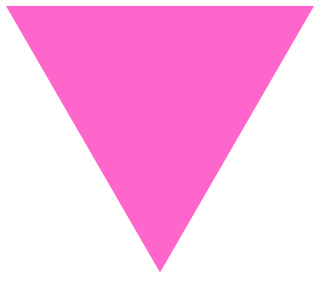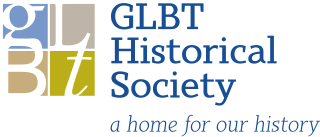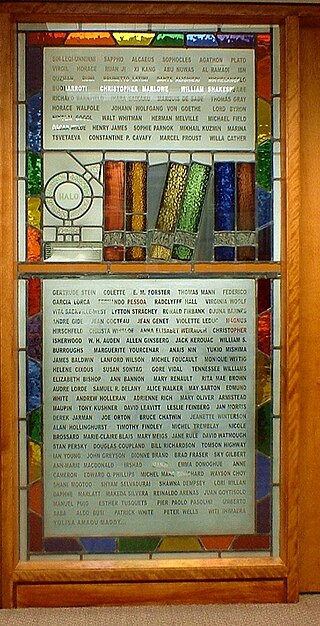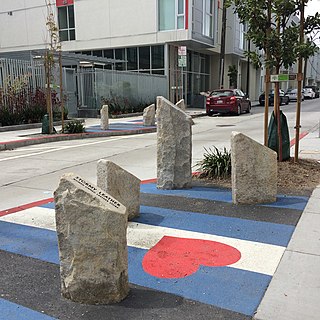Related Research Articles

A pink triangle has been a symbol for the LGBT community, initially intended as a badge of shame, but later reappropriated as a positive symbol of self-identity. In Nazi Germany in the 1930s and 1940s, it began as one of the Nazi concentration camp badges, distinguishing those imprisoned because they had been identified by authorities as gay men or trans women. In the 1970s, it was revived as a symbol of protest against homophobia, and has since been adopted by the larger LGBT community as a popular symbol of LGBT pride and the LGBT movements and queer liberation movements.

Queer Nation is an LGBTQ activist organization founded in March 1990 in New York City, by HIV/AIDS activists from ACT UP. The four founders were outraged at the escalation of anti-gay violence on the streets and prejudice in the arts and media. The group is known for its confrontational tactics, its slogans, and the practice of outing.
Over the course of its history, the LGBTQ community has adopted certain symbols for self-identification to demonstrate unity, pride, shared values, and allegiance to one another. These symbols communicate ideas, concepts, and identity both within their communities and to mainstream culture. The two symbols most recognized internationally are the pink triangle and the rainbow flag.

LGBTQ themes in horror fiction refers to sexuality in horror fiction that can often focus on LGBTQ+ characters and themes within various forms of media. It may deal with characters who are coded as or who are openly LGBTQ+, or it may deal with themes or plots that are specific to gender and sexual minorities.

The Pansy Craze was a period of increased LGBT visibility in American popular culture from the late-1920s until the mid-1930s. During the "craze," drag queens — known as "pansy performers" — experienced a surge in underground popularity, especially in New York City, Chicago, Los Angeles, and San Francisco. The exact dates of the movement are debated, with a range from the late 1920s until 1935.
The Bay Area Reporter is a free weekly LGBT newspaper serving the LGBT communities in the San Francisco Bay Area. It is one of the largest-circulation LGBT newspapers in the United States, and the country's oldest continuously published newspaper of its kind.
Fruit, fruity, and fruitcake, as well as its many variations, are slang or even sexual slang terms which have various origins. These terms have often been used derogatorily to refer to LGBT people. Usually used as pejoratives, the terms have also been re-appropriated as insider terms of endearment within LGBT communities. Many modern pop culture references within the gay nightlife like "Fruit Machine" and "Fruit Packers" have been appropriated for reclaiming usage, similar to queer.

The GLBT Historical Society maintains an extensive collection of archival materials, artifacts and graphic arts relating to the history of LGBTQ people in the United States, with a focus on the LGBT communities of San Francisco and Northern California.

In the post-Stonewall era, the role of libraries in providing information and services to LGBTQ individuals has been a topic of discussion among library professionals. Libraries can often play an important role for LGBTQ individuals looking to find information about coming out, health, and family topics, as well as leisure reading. In the past 50 years, advocate organizations for LGBTQ content in libraries have emerged, and numerous theorists have discussed various aspects of LGBTQ library service including privacy concerns, programming, collection development considerations and librarian/staff education needs, as well as special services for juvenile and teen patrons.

LGBT culture in Portland, Oregon is an important part of Pacific Northwest culture.

The lesbian, gay, bisexual and transgender (LGBTQ) community in San Francisco is one of the largest and most prominent LGBT communities in the United States, and is one of the most important in the history of American LGBT rights and activism alongside New York City. The city itself has been described as "the original 'gay-friendly city'". LGBT culture is also active within companies that are based in Silicon Valley, which is located within the southern San Francisco Bay Area.

The White Horse Inn is a gay bar located at 6551 Telegraph Avenue in Oakland's Bushrod Park neighborhood. It officially opened in 1933 but is rumored to have operated as a gay speakeasy since before the end of Prohibition. It is said to be the oldest continuously operating gay bar in the United States, along with Cafe Lafitte in New Orleans, Louisiana which has also operated since 1933. The White Horse is situated geographically near the Oakland-Berkeley border and in close proximity to the University of California, Berkeley campus.

The Stud is a gay bar currently located on 1123 Folsom Street in San Francisco.
Raymond Broshears was a gay Pentecostal Evangelist preacher and activist who founded the Lavender Panthers, an armed self-defense group for the LGBT community in San Francisco, active from the summer of 1973 until the spring of 1974. He also helped organize the first gay pride march in San Francisco in June 1972 and founded the Orthodox Episcopal Church of God.

The San Francisco South of Market Leather History Alley consists of four works of art that honor the history of gay and lesbian leather culture in South of Market, San Francisco. The art is embedded in Ringold Street, an alley between 8th and 9th Street. The installation opened in 2017. The alley is part of the Leather and LGBTQ Cultural District.

Lavender Woman was a lesbian periodical produced in Chicago, Illinois, from 1971 to 1976. The name Lavender Woman comes from the color lavender's prominence as a representation of homosexuality, starting in the 1950s and 1960s. It is believed that the color became a symbol due to it being a product of mixing baby blue and pink. Lavender truly hit the spotlight as a symbol of homosexuality empowerment in 1969 when lavender sashes and armbands were distributed during a "gay power" march in New York.

LesBiGay Radio was a radio show catering to the LGBT population of Chicago, Illinois. A contraction of lesbian, bisexual, and gay, the radio program was founded in June 1994 by Alan Amberg, and broadcast until April 2001, just shy of its 7th anniversary.

The Eldorado was the name of multiple nightclubs and performance venues in Berlin before the Nazi era and World War II. The name of the cabaret Eldorado has become an integral part of the popular iconography of the Weimar Republic. Two of the five locations the club occupied in its history are known to have catered to a gay crowd, although attendees would have included not only gay, lesbian, and bisexual patrons but also those identifying as heterosexual.
Adrienne Louise Fuzee was an American artist, curator, gallerist, editor, poet, and activist, based in California.
Queer for Fear: The History of Queer Horror is a 2022 television documentary series from the AMC-owned streaming network Shudder and Steakhaus Productions, executive produced by Bryan Fuller and Steak House.
References
- ↑ "Bay Area Reporter 28 April 1994 — California Digital Newspaper Collection". cdnc.ucr.edu. Retrieved 2022-02-16.
- ↑ Pansy Division - "Hippy Dude" ('live' on Lavender Lounge) , retrieved 2022-02-15
- ↑ "Music". Pansy Division. 2019-04-24. Retrieved 2022-02-16.
- ↑ Bay Area Reporter, Volume 22, Number 6, 6 February 1992. GLBT Historical Society. Benro Enterprises, Inc. 1992-02-06.
{{cite book}}: CS1 maint: others (link) - ↑ Bay Area Reporter, Volume 21, Number 52, 26 December 1991. GLBT Historical Society. Benro Enterprises, Inc. 1991-12-26.
{{cite book}}: CS1 maint: others (link) - ↑ Stark, John (1992-03-29). "TELEVISION; Combing a Nation For the Weirdest In Cable Fare". The New York Times. ISSN 0362-4331 . Retrieved 2022-02-15.
- ↑ "Bay Area Reporter 28 April 1994 — California Digital Newspaper Collection". cdnc.ucr.edu. Retrieved 2022-02-16.
- ↑ Johnson, Phylis W.; Keith, Michael C. (2014-12-18). Queer Airwaves: The Story of Gay and Lesbian Broadcasting: The Story of Gay and Lesbian Broadcasting. Routledge. ISBN 978-1-317-46151-7.
- ↑ Johnson, Phylis W.; Keith, Michael C. (2014-12-18). Queer Airwaves: The Story of Gay and Lesbian Broadcasting: The Story of Gay and Lesbian Broadcasting. Routledge. ISBN 978-1-317-46151-7.
- ↑ "Bay Area Reporter 28 April 1994 — California Digital Newspaper Collection". cdnc.ucr.edu. Retrieved 2022-02-15.